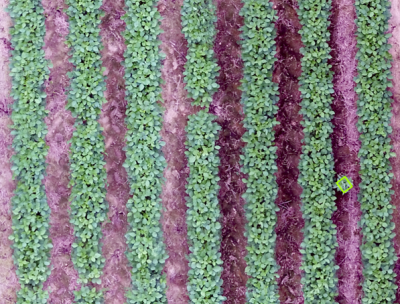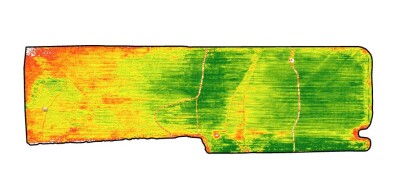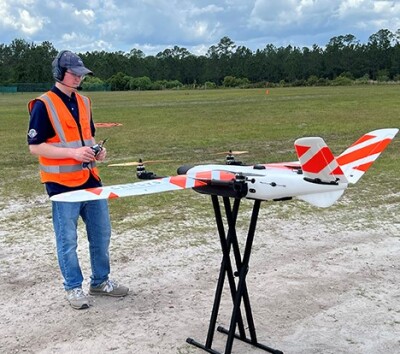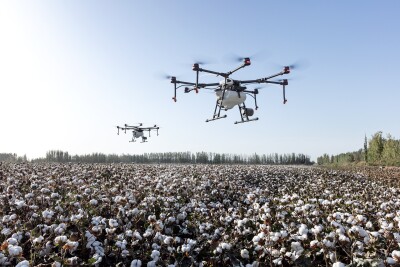Some of the most important work concerning drones in agriculture is happening in the world of education. In the United States and beyond, schools are providing comprehensive training on uncrewed systems to enable agriculture students and farming professionals to learn how to fly a drone, how to collect and analyze drone-derived data, and how to adapt to the technology to improve spraying, crop monitoring, and other applications.
For example, Michigan State University’s Institute of Agricultural Technology offers an Unmanned Aircraft Systems (UAS) Training Program aimed at improving precision agriculture practices. A similar program at Murray State University teaches students focused on agriculture or earth and environmental sciences how to use drones and mapping technology to “determine crop health, examine soil types and elevation and more.”  Moreover, online courses offered through Clemson University help would-be drone professionals obtain a Part 107 license, understand thermography and 3-D modeling, and comply with relevant regulations.
Moreover, online courses offered through Clemson University help would-be drone professionals obtain a Part 107 license, understand thermography and 3-D modeling, and comply with relevant regulations.
At the University of Arkansas System Division of Agriculture, a program is in place to help farmers better understand how uncrewed technologies can help their operations be more effective and valuable. Jason Davis, an assistant professor of remote sensing and pesticide application extension specialist at the school, told Commercial UAV News that the program helps farmers make better purchasing and operational decisions.
“I work in the areas of remote sensing and pesticide application to help Arkansas farmers use technology to be more efficient and profitable,” Davis said. “Working with our county agents, I help these producers make decisions regarding the purchase of precision agriculture technologies and their implementation.”
Davis and his colleagues “assist producers with their field equipment, adjustments to precision field computers, recommendations on drone hardware and software purchase, field data collection, drone and satellite imagery analysis,” Davis reported. In addition, he said, “we work to develop decision support tools that make imagery analysis and decision making easier for farmers.”
 Making the right decisions in these areas is essential as the integration of drones into farming operations can provide tremendous opportunities to increase efficiency and value. According to Davis, “Drones are a great remote sensing tool to gain a whole field perspective. They allow us to collect information about ongoing phenomenon in production fields. Compared with satellite imagery, we can explore in great detail what is happening now and how it is distributed.” With this data, Davis said, farmers “can facilitate correction of irrigation irregularities, plant disease or weed distributions, and monitor crop development.”
Making the right decisions in these areas is essential as the integration of drones into farming operations can provide tremendous opportunities to increase efficiency and value. According to Davis, “Drones are a great remote sensing tool to gain a whole field perspective. They allow us to collect information about ongoing phenomenon in production fields. Compared with satellite imagery, we can explore in great detail what is happening now and how it is distributed.” With this data, Davis said, farmers “can facilitate correction of irrigation irregularities, plant disease or weed distributions, and monitor crop development.”
Putting farmers in touch with experts like Davis is crucial to unlocking the potential of uncrewed systems. “Much of the remote sensing, drone, and geospatial analysis work is relatively new to farmers and, at this point, has limited adoption rates,” Davis reported. “County agent trainings have been focused on how to assist early adopting farmers with remotely sensed data analysis, and how these maps and data can help to inform production decisions.”
With training and assistance, farmers can make better use of drone-derived information. “There is an enormous amount of data available to producers between the information produced by their field equipment (planting, fertilizing, spraying, and harvest maps), available online (soil maps, satellite imagery, weather data), and now drone imagery,” Davis asserted.  “Making practical sense of this information is a challenge and much of it goes unused. Software programs, artificial intelligence algorithms, automated decision systems in the near future will hopefully help our producers to synthesize this data and use it to better informed production decisions.”
“Making practical sense of this information is a challenge and much of it goes unused. Software programs, artificial intelligence algorithms, automated decision systems in the near future will hopefully help our producers to synthesize this data and use it to better informed production decisions.”
Ultimately, the University of Arkansas program, and others like it around the world, can help farmers integrate new systems and derive new value. “The precision agriculture work we are doing now at University of Arkansas System Division of Agriculture will hopefully contribute to this effort by making big data more consumable for farmers ultimately making production agriculture in Arkansas more profitable and sustainable,” Davis said.















Comments